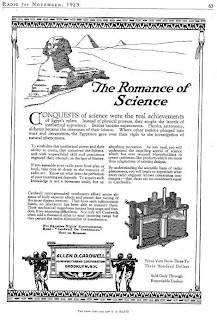In November of 1922, archaeologist Howard Carter made a striking discovery. Buried beneath the ruins of a worker's village, deep in The Valley of the Kings, lay the long-forgotten tomb of King Tutankhamen. The discovery of King Tut’s tomb sparked a craze for all things related to ancient Egypt. By 1923, American culture had been swept by "Egyptomania."
The rapidly-growing field of advertising was quick to pick up on the trend, and Egyptian imagery soon graced the packaging and print advertisements of a wide range of products. Although the exotic imagery was most often used to sell luxury goods, such as perfume and tobacco products, advertising agencies paired Egyptian themes with products as basic as soap and milk. Advertisers hoped that the Egyptian imagery would evoke connotations of luxury, excitement, wisdom, and longevity.
Furthermore, Egyptian imagery was also used to advertise technological products, linking the advanced methods used to build the pyramids with the sophistication and beauty of modern technology. The Allen D. Cardwell Manufacturing Corporation was one of the companies that used this tactic to advertise their products during the 1920s. Cardwell, a New York firm that made telecommunications equipment such as telegraph transmitters and capacitors, was founded at the turn of the 20th century. By the early 1920s, Cardwell had begun to sell radio parts, capitalizing on the rapidly growing demand for radio equipment spurred by the electrification of homes and the establishment of the first radio stations.
 In the fall of 1923, Cardwell ran an Egyptian-themed ad campaign designed by advertising mogul Frank Kiernan. The first ad, titled "The Masterbuilders of History," drew a parallel between the sophisticated technology of an ornate obelisk and Cardwell’s condensers:
In the fall of 1923, Cardwell ran an Egyptian-themed ad campaign designed by advertising mogul Frank Kiernan. The first ad, titled "The Masterbuilders of History," drew a parallel between the sophisticated technology of an ornate obelisk and Cardwell’s condensers:"In Egypt great obelisks stand as monuments of achievement to the masterbuilders of the ancient world. Symbolizing accuracy, durability, and beauty, each obelisk stands firmly on its foundation despite the passage of centuries. The same ideals of efficiency, ruggedness and craftsmanship are expressed in Cardwell rotor-ground condensers."
There were two versions of this advertisement; the first was directed at consumers, and ran in the October 1923 issue of Radio magazine, as well as in an issue of Popular Radio. The second version was targeted towards distributors of radio equipment, and ran in the trade publication Radio Merchandising.
 In the second ad of the Kiernan campaign, "The Romance of Science,” the great Sphinx towered over distant pyramids. The text of the ad claimed that “conquests of science were the real achievements of Egypt’s rulers," inviting consumers to “drink in the romance of radio art” and to begin "understanding the scientific basis of radio phenomena." This ad was featured in the November 1923 issue of Radio, as well as in Citizen’s Radio Call Back and Radio Broadcast Advertiser.
In the second ad of the Kiernan campaign, "The Romance of Science,” the great Sphinx towered over distant pyramids. The text of the ad claimed that “conquests of science were the real achievements of Egypt’s rulers," inviting consumers to “drink in the romance of radio art” and to begin "understanding the scientific basis of radio phenomena." This ad was featured in the November 1923 issue of Radio, as well as in Citizen’s Radio Call Back and Radio Broadcast Advertiser.This particular advertising campaign was unique in two ways: first, it was printed in color, which was still quite expensive in the 1920s (though it was becoming more popular for full-page advertisements). Second, the ads ran in multiple languages. A three-color Spanish language version of the first ad, titled "Los Arquitectos del Pasado," was featured in the October 1923 issue of Radio Record.
The Allen D. Cardwell Manufacturing Company records are processed and open for research at the Hagley Library. The collection includes a variety of promotional and technical materials, including patents, design drawings, newspaper and magazine articles, photographs, and promotional and sales material. The majority of the documents are from the years 1914 through 1955. A detailed finding aid is available online.
Contact the Hagley Archives and Manuscripts department for more information: research@hagley.org or 302-658-2400 ext 330.
Sources:
McDonald, Sally. Consuming Ancient Egypt. London: UCL Press, 2003.
By Jennifer Matthews, University of Delaware

